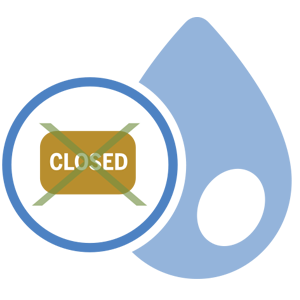Water tank inspection can be cumbersome, time consuming and expensive, but remote operating vehicle (ROV) technology is changing that. This short article outlines the five ways ROVs assist water tank inspections.
During a traditional water tank inspection, inspectors examine the tank for compliance with OSHA/American Water Works Association (AWWA) standards and guidelines. They examine coating condition, looking for cracking, peeling, delamination, blistering, and rusting. This visual process often involves either hiring an outside dive team to examine the inside of the tank or draining the tank to provide access. It can be both time consuming and expensive.
But ROV technology is helping to streamline things. Completing an ROV inspection requires a two-person team and one ROV. One team member climbs the tank to insert the ROV into the bowl while the other team member operates it from the ground using a remote-control panel. The ROV remains connected to the remote-control panel via a fiber optic cable. The ground operator controls the ROV and sees what the ROV camera records on a display. This assists with providing information for maintenance timelines, or full rehabilitation timelines.
Read more about the Deep Trekker ROV here.
Here are five ways ROV technology can benefit a city.

1. There is no down time for water availability
In a typical drain down inspection, a water tank is taken out of service while the inspection team enters the bowl. This requires wasting water that would otherwise be used by local residents. It also requires providing residents with an alternative means of water (continuous pumping or temporary water source) and requires the tank to be disinfected for AWWA compliance prior to returning to service. With an ROV, the water tank can remain in service while an inspection occurs.

2. They help conserve water
Tank inspection with a dive crew often involves removing some of the water for sediment removal or complete water removal for a drain down inspection. Removing water is costly and time-consuming. ROVs can operate inside a tank, regardless of how much or how little water is left in it, while still providing an overall inspection of the interior wet of the storage tank.

3. ROVs are cost effective
As mentioned above, there is no need to hire a costly dive team or remove any water from the storage tank. On a typical elevated water storage tank evaluation, savings can be up to 50 percent when using an ROV instead of a dive team. When your consultant owns its own ROV equipment, the cost savings can be substantial.

4. ROV inspections are more timely
For cities with multiple tanks, using an ROV creates the opportunity to inspect up to three tanks in one day. Using a dive team means only one inspection per day. In addition, waiting for a dive team takes time, but so does waiting for their reports. A typical wait for reports once a dive team completes an inspection is up to 30 days. After that, the consultant combines its findings and the dive team report before submitting to a client. Using an ROV streamlines the reporting process as it’s done by one entity.

5. They allow for peace of mind
A good consulting team operating an ROV is made up of Association for Materials Protection and Performance inspectors (AMPP formerly NACE/SSPC) and American Welding Society (AWS) certified personnel trained in providing water tower inspection services.
Bringing it all together
Water tank inspections are a part of utility operations. Regularly scheduled inspections make sure the tanks are clean, operate correctly, and a consistent schedule of inspections allows for easy, ongoing maintenance – a cost savings over time. The AWWA recommends an inspection every three to five years. Traditional visual inspections often involve the use of a separate dive team, which is costly and time consuming. Remote operating vehicles (ROVs) are helping to bridge that gap to bring savings to your city and residents.
Just for fun
Climbing to the top of a water tower can be a dizzying experience and is only for those certified for the task. Here's what it looks like climbing to the top inside of a water tower.

Brad Sipe is a protective coatings specialist and leader of SEH’s coatings group. He brings vast industry experience that includes recommending coatings systems for specific project needs, training clients on specification and application procedures, observing and documenting construction to ensure adherence to specs, and overseeing routine quality inspections.

.png?width=113&name=SEH_Logo_RGB%20(1).png)
